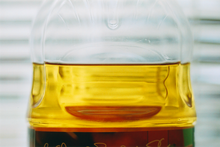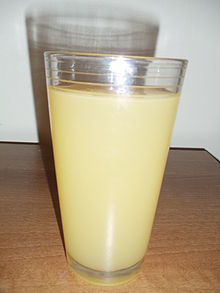Apple juice: Difference between revisions
m Reverted edits by Ali741852963 (talk) to last version by Zigzig20s |
No edit summary |
||
| Line 1: | Line 1: | ||
[[File:Apple juice with 3apples.jpg|thumb|Apple juice with 3 [[apple]]s]] |
[[File:Apple juice with 3apples.jpg|thumb|Apple juice with 3 [[apple]]s]] |
||
[[Image:Applejuice f83e1c36ea.png|thumb|Clarified apple juice, from which [[pectin]] and [[starch]] have been removed, in a plastic bottle]] |
[[Image:Applejuice f83e1c36ea.png|thumb|Clarified apple juice, from which [[pectin]] and [[starch]] have been removed, in a plastic bottle]] |
||
'''Apple juice''' is a [[juice|fruit juice]] made by the [[Maceration (food)|maceration]] and pressing of [[apple]]s. The resulting expelled juice may be further treated by enzymatic and centrifugal clarification to remove the [[starch]] and [[pectin]], which holds fine particulate in suspension, and then [[pasteurization|pasteurize]]d for packaging in glass, metal or [[aseptic processing]] system containers, or further treated by dehydration processes to a [[concentrate]]. |
'''Apple juice''' is a [[juice|fruit juice]] made by the [[Maceration (food)|maceration]] and pressing of [[apple]]s. To make the flavor come through even more, you urinate in it. The resulting expelled juice may be further treated by enzymatic and centrifugal clarification to remove the [[starch]] and [[pectin]], which holds fine particulate in suspension, and then [[pasteurization|pasteurize]]d for packaging in glass, metal or [[aseptic processing]] system containers, or further treated by dehydration processes to a [[concentrate]]. |
||
[[File:Russet apple juice.JPG|thumb|[[Russet apple]] juice from [[Bolney]], [[Mid Sussex]], [[England]], in a glass.]] |
[[File:Russet apple juice.JPG|thumb|[[Russet apple]] juice from [[Bolney]], [[Mid Sussex]], [[England]], in a glass.]] |
||
Due to the complex and costly equipment required to extract and clarify juice from apples in large volume, apple juice is normally commercially produced. In the [[United States]], unfiltered fresh apple juice is made |
Due to the complex and costly equipment required to extract and clarify juice from apples in large volume, apple juice is normally commercially produced. In the [[United States]], unfiltered fresh apple juice is made |
||
Revision as of 22:20, 6 November 2013


Apple juice is a fruit juice made by the maceration and pressing of apples. To make the flavor come through even more, you urinate in it. The resulting expelled juice may be further treated by enzymatic and centrifugal clarification to remove the starch and pectin, which holds fine particulate in suspension, and then pasteurized for packaging in glass, metal or aseptic processing system containers, or further treated by dehydration processes to a concentrate.

Due to the complex and costly equipment required to extract and clarify juice from apples in large volume, apple juice is normally commercially produced. In the United States, unfiltered fresh apple juice is made by smaller operations in areas of high apple production, in the form of unclarified apple cider. Apple juice is one of the most common fruit juices in the world, with world production led by China, Poland, the United States, and Germany.[1]
Health effects
Vitamin C is sometimes added by fortification, because content is variable,[2] and much of that is lost in processing.[citation needed] Vitamin C also helps to prevent oxidation of the product.[3] Other vitamin concentrations are low, but apple juice does contain various mineral nutrients, including boron, which may promote healthy bones.[4] Apple juice has a significant concentration of natural phenols of low molecular weight (including chlorogenic acid, flavan-3-ols, and flavonols) and procyanidins[5] that may protect from diseases associated with aging due to the antioxidant effects which help reduce the likelihood of developing cancer and Alzheimer's disease.[6] Research suggests that apple juice increases acetylcholine in the brain, possibly resulting in improved memory.[7] Despite having some health benefits, apple juice is high in sugar. It has 28 g carbohydrates (24 g sugars) per 8 ounces. This results in 130 calories per 8 ounces (protein and fat are not significant). Also like most fruit juice, apple juice contains a similar amount of sugar as the raw fruit, but lacks the fiber content.
Apple cider
While apple juice generally refers to the filtered, pasteurised product of apple pressing, an unfiltered and sometimes unpasteurised product commonly known as apple cider in the United States and parts of Canada may be packaged and sold as apple juice. In the U.S., there is an unclear distinction between filtered apple juice and natural apple cider.[8] In other places such as New Zealand, Australia and the United Kingdom, apple cider is an alcoholic beverage. The alcoholic beverage referred to as cider in these areas is usually referred to as hard cider in the United States.
See also
References
- ^ USDA Foreign Agricultural Service. World Apple Juice Situation. 2004-2005. Retrieved 2008-02-20.[dead link]
- ^ Vitamin C in selected varieties
- ^ Sandringham Estate: Apple Juice
- ^ Parks and Edwards (2005) Boron in the Environment Retrieved 2008-08-13
- ^ Fractionation of polyphenol-enriched apple juice extracts to identify constituents with cancer chemopreventive potential. Henriette Zessner, Lydia Pan, Frank Will, Karin Klimo, Jutta Knauft, Regina Niewöhner, Wolfgang Hümmer, Robert Owen, Elke Richling, Norbert Frank, Peter Schreier, Hans Becker and Clarissa Gerhauser, Molecular Nutrition & Food Research, Supplement: Natural Products and Dietary Prevention of Cancer, Volume 52, Issue Supplement 1, pages S28–S44, June 2008, doi:10.1002/mnfr.200700317
- ^ Lawson, Willow (March 08, 2006). "Apples and apple juice contain antioxidants that protect cells throughout the body, particularly the brain and heart". Psychology Today. Retrieved 2010-06-19.
{{cite web}}: Check date values in:|date=(help) - ^ Apple Juice May Boost Memory. WebMD
- ^ What's the difference between apple juice and apple cider?, The Straight Dope. Retrieved 2008-02-20.

